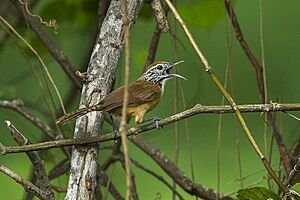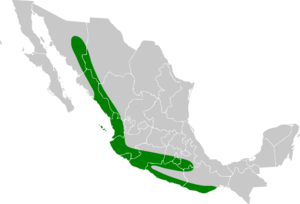Happy wren facts for kids
Quick facts for kids Happy wren |
|
|---|---|
 |
|
| Conservation status | |
| Scientific classification | |
| Genus: |
Pheugopedius
|
| Species: |
felix
|
 |
|
| Synonyms | |
|
Thryothorus felix |
|
The happy wren (Pheugopedius felix) is a small, cheerful bird that belongs to the Troglodytidae family, also known as the wren family. This special bird lives only in a specific part of western Mexico. You can find it along the Pacific coast, from the state of Sonora all the way down to Oaxaca. It also lives on some islands near the Mexican coast.
Scientists used to classify the happy wren in a different group called Thryothorus. But now, they agree it belongs to the Pheugopedius group. There are six different types, or subspecies, of the happy wren. Each subspecies lives in a slightly different area of Mexico:
- P. f. sonorae lives in southern Sonora and northern Sinaloa.
- P. f. pallidus is found in central Sinaloa, western Durango, and south to Jalisco and Michoacán.
- P. f. lawrencii and P. f. magdalenae live on different islands of the Islas Marías.
- P. f. grandis makes its home in the Balsas River basin.
- The main type, P. f. felix, lives in southwestern Mexico, from Jalisco to Oaxaca.
What Does the Happy Wren Look Like?
Happy wrens are small birds, usually about 12.5 to 14 centimeters long. That's about the length of your hand! It's hard to tell the difference between male and female happy wrens because they look very similar.
These wrens have a distinctive look. They have a cool black and white striped pattern on their face. Their upper body is a warm chestnut color, and their belly is a creamy white. They also have a bill that curves slightly downwards.
Where Do Happy Wrens Live?
Happy wrens prefer to live in warm, sunny places. Their natural habitats include different types of forests and shrublands.
- They like subtropical or tropical dry forests.
- They also live in moist lowland forests in tropical areas.
- You can find them in dry shrublands too.
- Sometimes, they even live in areas where forests used to be, but have changed a lot.
The happy wren builds a unique nest. It's shaped like a ball, almost like a small, round house. It has a special entrance that points downwards, like a little slide. This design helps keep their eggs and babies safe.


